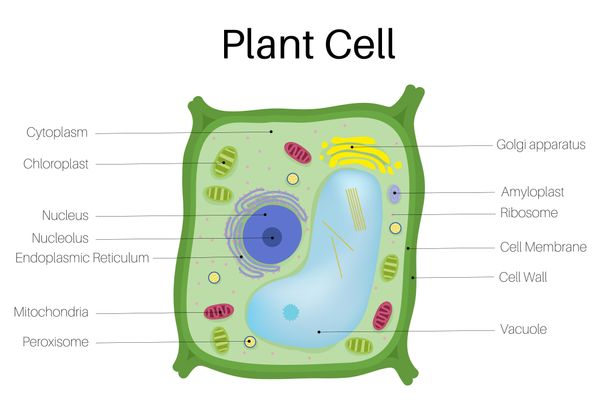1.3.1
Introduction to Cells
Eukaryotic vs Prokaryotic Cells
Eukaryotic vs Prokaryotic Cells
All life on Earth exists as cells. A cell is the smallest unit of a living thing. All cells can be grouped into either eukaryotic or prokaryotic cells. These different categories have similarities and differences.


Similarities
Similarities
- Both prokaryotic and eukaryotic cells contain organelles.
- The cell-surface membrane in eukaryotic and prokaryotic cells is made of a phospholipid bilayer.
- This bilayer is responsible for controlling the passage of substances across exchange surfaces.


Differences
Differences
- Prokaryotic cells make up single-celled prokaryotic organisms (e.g. bacteria). In contrast, eukaryotic cells make up complex eukaryotic organisms (e.g. animals, plants, fungi and algae).
- Eukaryotic cells are larger and more complex than prokaryotic cells.
- Cells arise from other cells by binary fission in prokaryotic cells and by mitosis or meiosis in eukaryotic cells.
Types of Eukaryotic Cells
Types of Eukaryotic Cells
Eukaryotic cells have similar structures across different types of organisms. But there are some key differences that are outlined here.


Animal cell
Animal cell
- Most animal cells have the following organelles:
- Mitochondria.
- Ribosomes.
- Endoplasmic reticulum (ER).
- Golgi.
- Lysosomes.
- Nucleus.
- Animal cells are enclosed by a cell membrane.


Plant cell
Plant cell
- Plant cells contain all the organelles found in animal cells.
- Plant cells also possess:
- Vacuole (a repository of cell sap).
- Chloroplasts (the site of photosynthesis).
- Cell wall (made of cellulose and contains plasmodesmata, through which cells exchange substances with each other).


Algal cells
Algal cells
- Algal cells and plant cells have an identical set of organelles.


Fungal cells
Fungal cells
- Fungal cells are similar to plant cells, apart from:
- There are no chloroplasts in fungal cells.
- The cell walls of fungal cells are made from chitin instead of cellulose.
1Principles of Science I
1.1Structure & Bonding
1.1.1Atomic Model
1.1.2Electron Shells, Sub-Shells & Orbitals
1.1.3Ionic Bonding
1.1.4Representing Ionic Bonds
1.1.5Covalent Bonding
1.1.6Representing Covalent Bonds
1.1.7Metallic Bonding
1.1.8Intermolecular Forces
1.1.9Intermolecular Forces 2
1.1.10End of Topic Test - Bonding
1.1.11Relative Masses
1.1.12The Mole
1.1.13Molar Calculations
1.1.14Molar Calculations 2
1.1.15Empirical & Molecular Formulae
1.1.16Balanced Equations
1.1.17Percentage Yield
1.1.18End of Topic Test - Amount of Substance
1.2Properties of Substances
1.2.1The Periodic Table
1.2.2Ionisation Energy
1.2.3Factors Affecting Ionisation Energies
1.2.4Trends of Ionisation
1.2.5Trends in the Periodic Table
1.2.6Polarity
1.2.7Metals & Non-Metals
1.2.8Alkali Metals
1.2.9Alkaline Earth Metals
1.2.10Reactivity of Alkaline Earth Metals
1.2.11Redox
1.2.12Transition Metals
1.2.13Redox Reactions of Transition Metals
1.3Cell Structure & Function
1.4Cell Specialisation
1.5Tissue Structure & Function
1.5.1Human Gas Exchange
1.5.2Blood Vessels
1.5.3Atherosclerosis
1.5.4Skeletal Muscle
1.5.5Slow & Fast Twitch Fibres
1.5.6Neurones
1.5.7Speed of Transmission
1.5.8Action Potentials
1.5.9End of Topic Test - Neurones & Action Potentials
1.5.10Synapses
1.5.11Types of Synapse
1.5.12Medical Application
1.5.13End of Topic Test - Synapses
1.5.14Chemical Brain Imbalances
1.5.15Effect of Drugs on the Brain
1.6Working with Waves
1.7Waves in Communication
2Practical Scientific Procedures and Techniques
3Science Investigation Skills
3.1Scientific Processes
3.2Data Handling & Analysis
3.3Enzymes in Action
3.4Diffusion
3.5Plants & Their Environment
3.6Energy Content in Fuels
4Principles of Science II
4.1Extracting Elements
4.2Relating Properties to use of Substances
4.3Organic Chemistry
4.4Energy Changes in Industry
4.5The Circulatory System
4.5.1The Circulatory System
4.5.2Blood Vessels
4.5.3Blood Transfusion & the ABO Rhesus System
4.5.4The Heart
4.5.5The Cardiac Cycle
4.5.6Cardiac Output
4.5.7Coordination of Heart Action
4.5.8Heart Dissection
4.5.9Controlling Heart Rate
4.5.10Electrocardiograms
4.5.11Cardiovascular Disease
4.5.12Investigating Heart Rates
4.6Ventilation & Gas Exchange
4.7Urinary System
4.9Thermal Physics
4.9.1Power & Efficiency
4.9.2Work & Energy
4.9.3Conservation of Energy
4.9.4Pressure
4.9.5First Law of Thermodynamics
4.9.6Second Law of Thermodynamics
4.9.7Heat Engines, Heat Pumps & Refrigerators
4.9.8Non-Flow Processes
4.9.9p-V Diagrams
4.9.10Ideal Gases
4.9.11Ideal Gases 2
4.9.12Thermal Energy Transfer
4.9.13Thermal Energy Transfer Experiments
4.10Materials
5Contemporary Issues in Science
5.1Contemporary Issues in Science
5.2Analysing Scientific Information
Jump to other topics
1Principles of Science I
1.1Structure & Bonding
1.1.1Atomic Model
1.1.2Electron Shells, Sub-Shells & Orbitals
1.1.3Ionic Bonding
1.1.4Representing Ionic Bonds
1.1.5Covalent Bonding
1.1.6Representing Covalent Bonds
1.1.7Metallic Bonding
1.1.8Intermolecular Forces
1.1.9Intermolecular Forces 2
1.1.10End of Topic Test - Bonding
1.1.11Relative Masses
1.1.12The Mole
1.1.13Molar Calculations
1.1.14Molar Calculations 2
1.1.15Empirical & Molecular Formulae
1.1.16Balanced Equations
1.1.17Percentage Yield
1.1.18End of Topic Test - Amount of Substance
1.2Properties of Substances
1.2.1The Periodic Table
1.2.2Ionisation Energy
1.2.3Factors Affecting Ionisation Energies
1.2.4Trends of Ionisation
1.2.5Trends in the Periodic Table
1.2.6Polarity
1.2.7Metals & Non-Metals
1.2.8Alkali Metals
1.2.9Alkaline Earth Metals
1.2.10Reactivity of Alkaline Earth Metals
1.2.11Redox
1.2.12Transition Metals
1.2.13Redox Reactions of Transition Metals
1.3Cell Structure & Function
1.4Cell Specialisation
1.5Tissue Structure & Function
1.5.1Human Gas Exchange
1.5.2Blood Vessels
1.5.3Atherosclerosis
1.5.4Skeletal Muscle
1.5.5Slow & Fast Twitch Fibres
1.5.6Neurones
1.5.7Speed of Transmission
1.5.8Action Potentials
1.5.9End of Topic Test - Neurones & Action Potentials
1.5.10Synapses
1.5.11Types of Synapse
1.5.12Medical Application
1.5.13End of Topic Test - Synapses
1.5.14Chemical Brain Imbalances
1.5.15Effect of Drugs on the Brain
1.6Working with Waves
1.7Waves in Communication
2Practical Scientific Procedures and Techniques
3Science Investigation Skills
3.1Scientific Processes
3.2Data Handling & Analysis
3.3Enzymes in Action
3.4Diffusion
3.5Plants & Their Environment
3.6Energy Content in Fuels
4Principles of Science II
4.1Extracting Elements
4.2Relating Properties to use of Substances
4.3Organic Chemistry
4.4Energy Changes in Industry
4.5The Circulatory System
4.5.1The Circulatory System
4.5.2Blood Vessels
4.5.3Blood Transfusion & the ABO Rhesus System
4.5.4The Heart
4.5.5The Cardiac Cycle
4.5.6Cardiac Output
4.5.7Coordination of Heart Action
4.5.8Heart Dissection
4.5.9Controlling Heart Rate
4.5.10Electrocardiograms
4.5.11Cardiovascular Disease
4.5.12Investigating Heart Rates
4.6Ventilation & Gas Exchange
4.7Urinary System
4.9Thermal Physics
4.9.1Power & Efficiency
4.9.2Work & Energy
4.9.3Conservation of Energy
4.9.4Pressure
4.9.5First Law of Thermodynamics
4.9.6Second Law of Thermodynamics
4.9.7Heat Engines, Heat Pumps & Refrigerators
4.9.8Non-Flow Processes
4.9.9p-V Diagrams
4.9.10Ideal Gases
4.9.11Ideal Gases 2
4.9.12Thermal Energy Transfer
4.9.13Thermal Energy Transfer Experiments
4.10Materials
5Contemporary Issues in Science
5.1Contemporary Issues in Science
5.2Analysing Scientific Information
Unlock your full potential with Seneca Premium
Unlimited access to 10,000+ open-ended exam questions
Mini-mock exams based on your study history
Unlock 800+ premium courses & e-books
